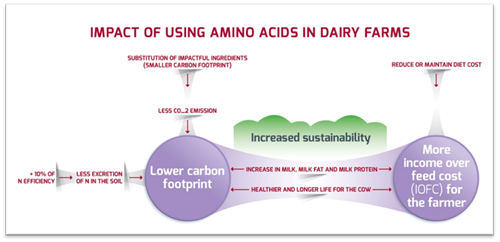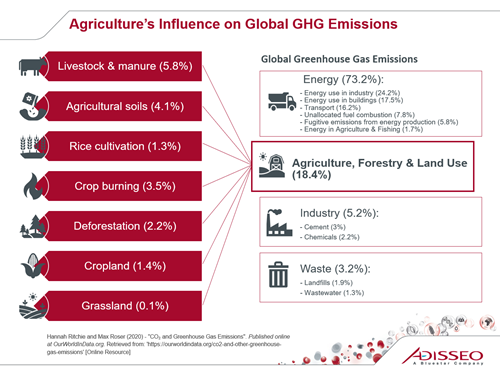05 January 2022 - Adisseo’s core business of providing amino acid balancing solutions to the ruminant sector gives it a unique insight into the challenges faced in delivering sustainable solutions to feed the planet. According to Uwizeye et al. (2020), the livestock sector emits 65 Tg of nitrogen each year. That equals one third of the current human-induced nitrogen emissions and mainly results from the application of nitrogen fertilizers and manure on the soil. Although this is less than 6% of total global greenhouse gas emissions, according to Our World in Data, the industry still needs to focus on reducing greenhouse gas to be sustainable.
Ruminants use only a part of the nutrients and nitrogen present in their feed. Only 5-45% of the total quantity of nitrogen ingested is transformed into animal products (Oenema et al. 2008). The remaining part is excreted through the feces and urine and is then released into the environment. The various forms of nitrogen emissions can negatively impact land and water. Acidification changes the chemical composition of surface water and soil, making it more difficult for plants to assimilate nutrients. This results in decreased plant growth. Ammonia and NOx emissions not only contribute to climate change, but also lower air quality and disrupt freshwater aquatic ecosystems by contributing to a loss of biodiversity and eutrophication.
Given these potential harmful effects, it is essential that the industry takes these emissions seriously and takes steps to improve the situation. A major priority for Adisseo is to be actively partnering with customers to develop solutions and educate the industry on the alternatives available. In today’s Industry Perspective, Brian Sloan, Business and Technical Director of Ruminant Amino Acids and Protected Nutrients, and Amel Hocini, Project Chief for Sustainability, identify how the ruminant industry has the tools to do better. Moreover, using these tools effectively can also lead to improved animal performance, reduced feed nitrogen inputs, and lower dependence on imported protein ingredients (which are themselves greenhouse gas-intensive). Finally, improved health and reproductive performance is associated with an increase in the productive life of dairy cows due to less voluntary culling, which further decreases the carbon footprint.
[Feedinfo] How do ruminants differ from monogastric animals in terms of nitrogen use efficiency?
[Brian Sloan] Nitrogen efficiency in animal production is defined as the proportion of nitrogen ingested that is retained as edible protein for human consumption (Van der Hoek et al., 1998). The nitrogen efficiency in ruminants is about 25% on average (Calsamiglia et al., 2010). This efficiency is highly variable, ranging from 10 to 40%.
|
|
While ruminants have a lower nitrogen efficiency than monogastrics, they have the advantage of being able to use sources of nitrogen that pigs and poultry cannot transform, particularly non-protein nitrogen sources and nitrogen in forages. This is due to differences in their gastrointestinal tracts. Monogastrics have only one stomach. Digestion begins here and continues in the intestine where nutrients are absorbed. Ruminants have four stomachs with a foregut fermenter-type digestion. The feed ingested by ruminants is degraded and fermented by rumen microorganisms. |
Volatile fatty acids (the main source of energy for ruminant animals) and microbial protein are produced. Thus, a large proportion of the amino acids available for productive purposes indirectly results from the consumption of forages . This is particularly true for lactating dairy cow rations and growing ruminants. Therefore, amino acid-rich food of animal origin is produced without competition for feed with non-ruminants and humans.
From the point of view of the nitrogen cycle, however, it is not very efficient (Flachowsky et al., 2013). Rumen metabolism is what most affects the inefficiency of nitrogen use by ruminants (Tamminga, 1992). This low efficiency has implications not only for production performance and economic efficiency but also for the emission of contaminants into the environment. Although important milestones have been achieved in terms of improving the efficiency of nitrogen use, it is still possible to improve this efficiency further.
[Feedinfo] Is this inefficiency an inevitable part of raising cattle or can it be overcome with certain nutritional tools? What can be used to address this?
[Brian Sloan] This inefficiency can be reduced by various types of on-farm improvements. One of these is certainly the administration of diets which are properly formulated and balanced for amino acid levels. To do this, first it is necessary to feed the rumen with adequate nitrogen to maximize fermentation. The goal is to generate the optimum digestion of forages and other components of the diet to produce volatile fatty acids. These are the principal energy fuels for the animal’s maintenance and production. At the same time, the ration should maximize the rumen’s microbial protein production.
Even so, the microbial protein contribution rarely exceeds 60% of the protein needed to achieve the cow’s target production. Therefore, additional bypass protein must be fed to complement the microbial contribution. Unfortunately bypass protein typically does not have an optimum amino acid profile. Thus, rations historically were formulated so excess protein was fed. Overfeeding, however, results in poor overall nitrogen efficiency.
In recent decades, significant progress has been made in determining the important roles of individual essential amino acids in the production of milk and milk components. For example, the essential amino acid methionine makes significant longer-term contributions to health, reproductive performance, and cow longevity. The pioneering ration evaluation models of INRA (EU) and Cornell University (USA) both recognize the importance of the methionine absorbed by the dairy cow. These are readily available on commercial software platforms providing the nutritionist the easy-to-use formulation tools to meet individual amino acid requirements without the need to feed excess protein.
The scientific literature clearly demonstrates how methionine is the first limiting essential amino acid for dairy cows. Its lack causes suboptimal milk performance, increased likelihood of metabolic disorders and poor reproductive performance. For example, Toledo et al. in 2017 evaluated the effects of addressing the deficit in methionine by providing daily rumen protected methionine (Smartamine® M) on a large commercial dairy in the US Midwest. In addition to the expected improvements in milk component yields, embryonic size in multiparous cows was improved, leading to less embryonic death.
Supplementing the diet with methionine as part of ration amino acid balancing allows the ruminant’s nutritional requirement to be met and the protein content in the diet to be decreased. The average nitrogen efficiency of a cow producing 30 kg of milk on a conventional ration is generally a little below 30%. With a revised diet using either the protected methionine Smartamine M or MetaSmart®, this efficiency can reach more than 35%. Proper amino acid balancing along with the decrease in the nitrogen content is associated with better production (more milk protein content, less milk urea, and increased milk yield).
[Feedinfo] How much of an impact can interventions such as amino acid balancing have on the CO2 footprint and nitrogen discharge of a dairy farm? Are these just marginal effects, or can they have a significant contribution? Under what conditions and for what types of farms is this most effective?
|
[Amel Hocini] Rations with balanced amino acid levels contribute to sustainability in at least two different ways. First, substitutions can be made to use feedstuffs with smaller carbon footprints. Second, increasing nitrogen use efficiency decreases nitrogen emissions into the environment. Beyond sustainability, income over feed cost (IOFC) will be increased or maintained. This results from a more judicious selection of the dietary ingredients, and increasing milk yield and components. Furthermore, meeting the cow’s methionine requirement improves health status and longevity. This contributes both to farm income and sustainability. |
Amel Hocini |
A recent demonstration of the efficacy of this approach was carried out in Brittany as part of the SOS Protein program. This on-farm trial lasted several months during the winter of 2018-19 under the supervision of INRA. It confirmed the effectiveness of the technique. It allowed for the use of local energy resources that were produced on the farm in conjunction with reduced levels of soybean meal and supplementation with rumen-protected methionine and lysine. These changes succeeded not only in maintaining performance but also improving milk production and components.
As part of the SOS Protein Program, the rations that were balanced for amino acids and fed were then re-evaluated. They showed a decrease in CO2 impact and nitrogen discharge which helped mitigate the effects on global warming or eutrophication of water.
The results show that the diet balanced for amino acids is beneficial. While being less expensive, it consumes fewer resources and allows less urinary nitrogen loss, the primary nitrogen loss for cows. For countries and areas with high levels of pollution due to high levels of nitrates in the soil, the amino acid diet can make a significant contribution to the management of soil nitrogen levels.
The interpretation of this study can be extrapolated, taking into account what we already know about the effects of amino acid balancing with methionine on production, health, and reproduction. When you do so, you see that the dairy cows will have a longer productive life in the dairy herd. For this reason, the benefits can be considered under four different aspects: production, health, reproduction and longevity.
If, hypothetically, diets were amino acid balanced with rumen protected methionine on all French farms, the import of soybean meal could have fallen by 500,000 tons in 2018, a 50% decrease in tonnage used by French dairy cows.
Based on 30 quintals/ ha (average yield in France) of soybean and 80% yield of seed cake, this saved tonnage would represent an area of 200,000 ha saved and 5,400 fewer tons of CO2 released due to transportation from Brazil to France.
 |
When ration costs are optimized and combined with more efficient animals that produce more milk with higher component levels, farmers can increase their income and provide a more environmentally friendly milk supply. |
[Feedinfo] How much commitment is there from the dairy and beef sectors to improving their herds’ environmental efficiency? In what parts of the market do you see growing levels of interest in concepts such as amino acid balancing and other solutions which can contribute to improving nitrogen use efficiency, CO2 footprint, or other environmental metrics?
|
[Amel Hocini] The commitment of farms to increasing their sustainability varies but is growing. In fact, from both an ethical and commercial point of view it is increasingly important for farms to take care of their sustainability. |
|
Elsewhere, California is a leader in the U.S. in implementing measures for emission reductions, setting ambitious goals such as reducing GHG emissions by 40% by 2030. In California, producing one kg of milk now results in 50% lower emissions than 50 years ago (Naranjo et al., 2020). Beyond California’s borders, the U.S. dairy industry, which is responsible for 2% (Mitloehner et al., 2020) of the nation’s total emissions, has announced efforts to combat climate change with the goal of achieving carbon neutrality by 2050.
Indeed, the interest in reducing emissions has become something that unites all regions of the world. Brazil has the ABC Plan, a national plan for low carbon emissions in agriculture with a total budget of US $1.5 billion. New Zealand is working on a plan to reduce nitrogen emissions that will be completed in 2025. In Europe, the Nitrates Directive regulates the introduction of organic nitrogen into the soil. In general, sustainability has become fundamental in all production activities around the world, therefore, it is important to innovate and know how to innovate to continue feeding the planet with the least possible impact.
It is also important to note that guaranteeing the success of a transformation like this requires industry cooperation. We need to work together to educate the market and leverage our key opinion leaders. This will enable us to collaborate on a common sustainability vision while working through the professional associations. Increasingly the process of change in the EU is being led by working groups within FEFENA, the EU Association of Specialty Feed Ingredients and their Mixtures; IFIF, the International Feed Industry Federation; and FEFAC, the European Feed Manufacturer’s Federation to name a few.
Finally, it is as important to reduce the footprint upstream from the value chain as it is to use additives and supplements that lower the impact downstream. Adisseo currently is mobilizing its teams and investing in R&D to start new studies and trials related to sustainability in collaboration with customers. It is crucial to have accurate and relevant figures to establish credibility and integrity. It also requires collaboration with new partners who are climate-change experts. For example, new measurement methodologies and recognized guidelines or standards are required, such as the strategic use of Life Cycle Assessments. Today’s actions will contribute to a better tomorrow.
Bibliography:
Calsamiglia, S., et al. "Strategies for optimizing nitrogen use by ruminants." Animal 4.7 (2010): 1184-1196.
Flachowsky, G., M. Gruen, and U. Meyer. "Feed-efficient ruminant production: opportunities and challenges." J Anim Feed Sci 22.3 (2013): 177-87.
Naranjo, A., et al. "Greenhouse gas, water, and land footprint per unit of production of the California dairy industry over 50 years." Journal of Dairy Science 103.4 (2020): 3760-3773.
Mitloehner et al. “Methane, Cows, and Climate Change: California Dairy’s Path to Climate Neutrality” clear.ucdavis.edu (2020).
Oenema, Oene, et al. "Gaseous nitrogen emissions from livestock farming systems." Nitrogen in the Environment. Academic Press, 2008. 395-441.
SOS Protein, INRA official trial on 5 farms, (4 months winter 2018-19).
Tamminga, S. "Nutrition management of dairy cows as a contribution to pollution control." Journal of Dairy Science 75.1 (1992): 345-357.
Toledo, Mateus Z., et al. "Effect of feeding rumen-protected methionine on productive and reproductive performance of dairy cows." PLoS One 12.12 (2017): e0189117.
Uwizeye, Aimable, et al. "Nitrogen emissions along global livestock supply chains." Nature Food 1.7 (2020): 437-446.
Van der Hoek, Klaas W. "Nitrogen efficiency in global animal production." Nitrogen, the Confer-Ns. Elsevier, 1998. 127-132.
Published in association with Adisseo

 Dr. Brian Sloan
Dr. Brian Sloan



